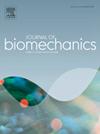How are athletes trained to move? A systematic review exploring the effects of implicit and explicit learning on biomechanics of sport-specific tasks
IF 2.4
3区 医学
Q3 BIOPHYSICS
引用次数: 0
Abstract
Motor learning might reduce the likelihood of sports injuries by improving movement patterns. This review aimed to critically evaluate and summarize the effects of implicit (IL) and explicit (EL) motor learning on selected biomechanical variables while executing sport-specific tasks. PubMed, Embase, and Cinahl were searched according to PRISMA guidelines. The protocol was registered in PROSPERO (ID: CRD42023390982). Randomised controlled trials published before February 2024, with healthy participants (≥11 years) performing a sport-specific task were considered. Intervention evaluation, at least one kinematic or kinetic value as dependent variable, needed to be minimally one night post-practice. The changes in biomechanical outcomes were considered regarding the goal of the included study and their effect sizes were assessed. Methodological quality was based on the Revised Cochrane Risk-of-Bias tool. Of 18,639 records identified, 25 studies were included leading to 60 comparisons between IL and control (CTRL), EL and CTRL, or IL and EL. In total, the 1020 (520 male, 20.0 ± 3.7 years, 14–91 per study) participants playedvarious sports, from recreational to elite level. External and internal focus of attention, differential learning, analogy, non-linear and linear pedagogy, and observational learning were included.. An overall small positive effect size of IL compared to CTRL group changes was found (g = 0.45 [0.115 – 0.780], p = 0.01). Although premature, IL shows more potential than EL for improving biomechanics of sport-specific tasks. Therefore, practitioners may consider incorporating IL into injury prevention programs. Lastly, recommendations about strengthening research methodology of motor learning studies using biomechanical outcomes are provided.
求助全文
约1分钟内获得全文
求助全文
来源期刊

Journal of biomechanics
生物-工程:生物医学
CiteScore
5.10
自引率
4.20%
发文量
345
审稿时长
1 months
期刊介绍:
The Journal of Biomechanics publishes reports of original and substantial findings using the principles of mechanics to explore biological problems. Analytical, as well as experimental papers may be submitted, and the journal accepts original articles, surveys and perspective articles (usually by Editorial invitation only), book reviews and letters to the Editor. The criteria for acceptance of manuscripts include excellence, novelty, significance, clarity, conciseness and interest to the readership.
Papers published in the journal may cover a wide range of topics in biomechanics, including, but not limited to:
-Fundamental Topics - Biomechanics of the musculoskeletal, cardiovascular, and respiratory systems, mechanics of hard and soft tissues, biofluid mechanics, mechanics of prostheses and implant-tissue interfaces, mechanics of cells.
-Cardiovascular and Respiratory Biomechanics - Mechanics of blood-flow, air-flow, mechanics of the soft tissues, flow-tissue or flow-prosthesis interactions.
-Cell Biomechanics - Biomechanic analyses of cells, membranes and sub-cellular structures; the relationship of the mechanical environment to cell and tissue response.
-Dental Biomechanics - Design and analysis of dental tissues and prostheses, mechanics of chewing.
-Functional Tissue Engineering - The role of biomechanical factors in engineered tissue replacements and regenerative medicine.
-Injury Biomechanics - Mechanics of impact and trauma, dynamics of man-machine interaction.
-Molecular Biomechanics - Mechanical analyses of biomolecules.
-Orthopedic Biomechanics - Mechanics of fracture and fracture fixation, mechanics of implants and implant fixation, mechanics of bones and joints, wear of natural and artificial joints.
-Rehabilitation Biomechanics - Analyses of gait, mechanics of prosthetics and orthotics.
-Sports Biomechanics - Mechanical analyses of sports performance.
 求助内容:
求助内容: 应助结果提醒方式:
应助结果提醒方式:


